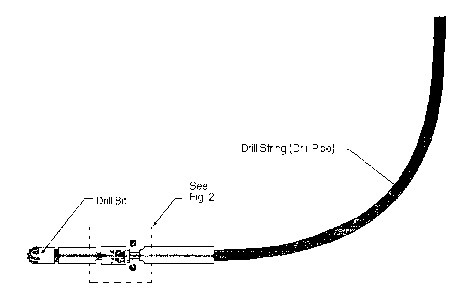Some of the information on this Web page has been provided by external sources. The Government of Canada is not responsible for the accuracy, reliability or currency of the information supplied by external sources. Users wishing to rely upon this information should consult directly with the source of the information. Content provided by external sources is not subject to official languages, privacy and accessibility requirements.
Any discrepancies in the text and image of the Claims and Abstract are due to differing posting times. Text of the Claims and Abstract are posted:
| (12) Patent Application: | (11) CA 2505564 |
|---|---|
| (54) English Title: | SPEED SENSITIVE ROTATIONAL DRIVE STEERABLE DRILLING SYSTEM |
| (54) French Title: | SYSTEME DE FORAGE ORIENTABLE A ENTRAINEMENT ROTATIF SENSIBLE A LA VITESSE |
| Status: | Deemed Abandoned and Beyond the Period of Reinstatement - Pending Response to Notice of Disregarded Communication |
| (51) International Patent Classification (IPC): |
|
|---|---|
| (72) Inventors : |
|
| (73) Owners : |
|
| (71) Applicants : |
|
| (74) Agent: | |
| (74) Associate agent: | |
| (45) Issued: | |
| (22) Filed Date: | 2005-04-04 |
| (41) Open to Public Inspection: | 2006-10-04 |
| Examination requested: | 2009-04-24 |
| Availability of licence: | N/A |
| Dedicated to the Public: | N/A |
| (25) Language of filing: | English |
| Patent Cooperation Treaty (PCT): | No |
|---|
| (30) Application Priority Data: | None |
|---|
The following is a proposal for a new steerable drill design for the oil and
gas
industry.
The design relies on variations in the rotational speed of the drill pipe
(also called
the drill string) controlled from the surface to steer the drill bit in the
desired
direction. The steering is accomplished by a hydraulic-mechanical system
consisting of a hydraulic pump, a speed sensing device, coupled to a selector
valve, which controls the angle of deflection of the bit and the direction of
the
deflection through 360 degrees.
The device will also be able to drill in a straight line by eliminating the
offset of
the bit to zero degrees as the rotational speed of the drill string is
increased
beyond the directional drilling speed range.
Rotation of the internal mechanism of the device, along with the rotation of
the
drill string will be prevented by an anti rotational device, consisting of a
gravity
sensing valve, hydraulic motor and wellbore tracking wheels. The device is
fully
hydro-mechanical in nature and does not incorporate mud motors or electronics
of any kind and is capable being used with standard oil field drilling rigs,
drill pipe
and drill bits.
Note: Claims are shown in the official language in which they were submitted.
Note: Descriptions are shown in the official language in which they were submitted.

2024-08-01:As part of the Next Generation Patents (NGP) transition, the Canadian Patents Database (CPD) now contains a more detailed Event History, which replicates the Event Log of our new back-office solution.
Please note that "Inactive:" events refers to events no longer in use in our new back-office solution.
For a clearer understanding of the status of the application/patent presented on this page, the site Disclaimer , as well as the definitions for Patent , Event History , Maintenance Fee and Payment History should be consulted.
| Description | Date |
|---|---|
| Application Not Reinstated by Deadline | 2010-04-06 |
| Time Limit for Reversal Expired | 2010-04-06 |
| Inactive: Adhoc Request Documented | 2010-01-07 |
| Inactive: Office letter | 2009-06-16 |
| Letter Sent | 2009-06-10 |
| Request for Examination Received | 2009-04-24 |
| Request for Examination Requirements Determined Compliant | 2009-04-24 |
| All Requirements for Examination Determined Compliant | 2009-04-24 |
| Deemed Abandoned - Failure to Respond to Maintenance Fee Notice | 2009-04-06 |
| Letter Sent | 2008-11-10 |
| Reinstatement Requirements Deemed Compliant for All Abandonment Reasons | 2008-10-23 |
| Deemed Abandoned - Failure to Respond to Maintenance Fee Notice | 2008-04-04 |
| Application Published (Open to Public Inspection) | 2006-10-04 |
| Inactive: Cover page published | 2006-10-03 |
| Inactive: First IPC assigned | 2005-06-15 |
| Inactive: IPC assigned | 2005-06-15 |
| Application Received - Regular National | 2005-05-31 |
| Inactive: Office letter | 2005-05-31 |
| Inactive: Filing certificate - No RFE (English) | 2005-05-31 |
| Small Entity Declaration Determined Compliant | 2005-04-04 |
| Abandonment Date | Reason | Reinstatement Date |
|---|---|---|
| 2009-04-06 | ||
| 2008-04-04 |
The last payment was received on 2008-10-23
Note : If the full payment has not been received on or before the date indicated, a further fee may be required which may be one of the following
Patent fees are adjusted on the 1st of January every year. The amounts above are the current amounts if received by December 31 of the current year.
Please refer to the CIPO
Patent Fees
web page to see all current fee amounts.
| Fee Type | Anniversary Year | Due Date | Paid Date |
|---|---|---|---|
| Application fee - small | 2005-04-04 | ||
| MF (application, 2nd anniv.) - small | 02 | 2007-04-04 | 2007-01-23 |
| MF (application, 3rd anniv.) - small | 03 | 2008-04-04 | 2008-10-23 |
| Reinstatement | 2008-10-23 | ||
| Request for examination - small | 2009-04-24 |
Note: Records showing the ownership history in alphabetical order.
| Current Owners on Record |
|---|
| JACOBUS HENDRIK VISSER |
| Past Owners on Record |
|---|
| None |